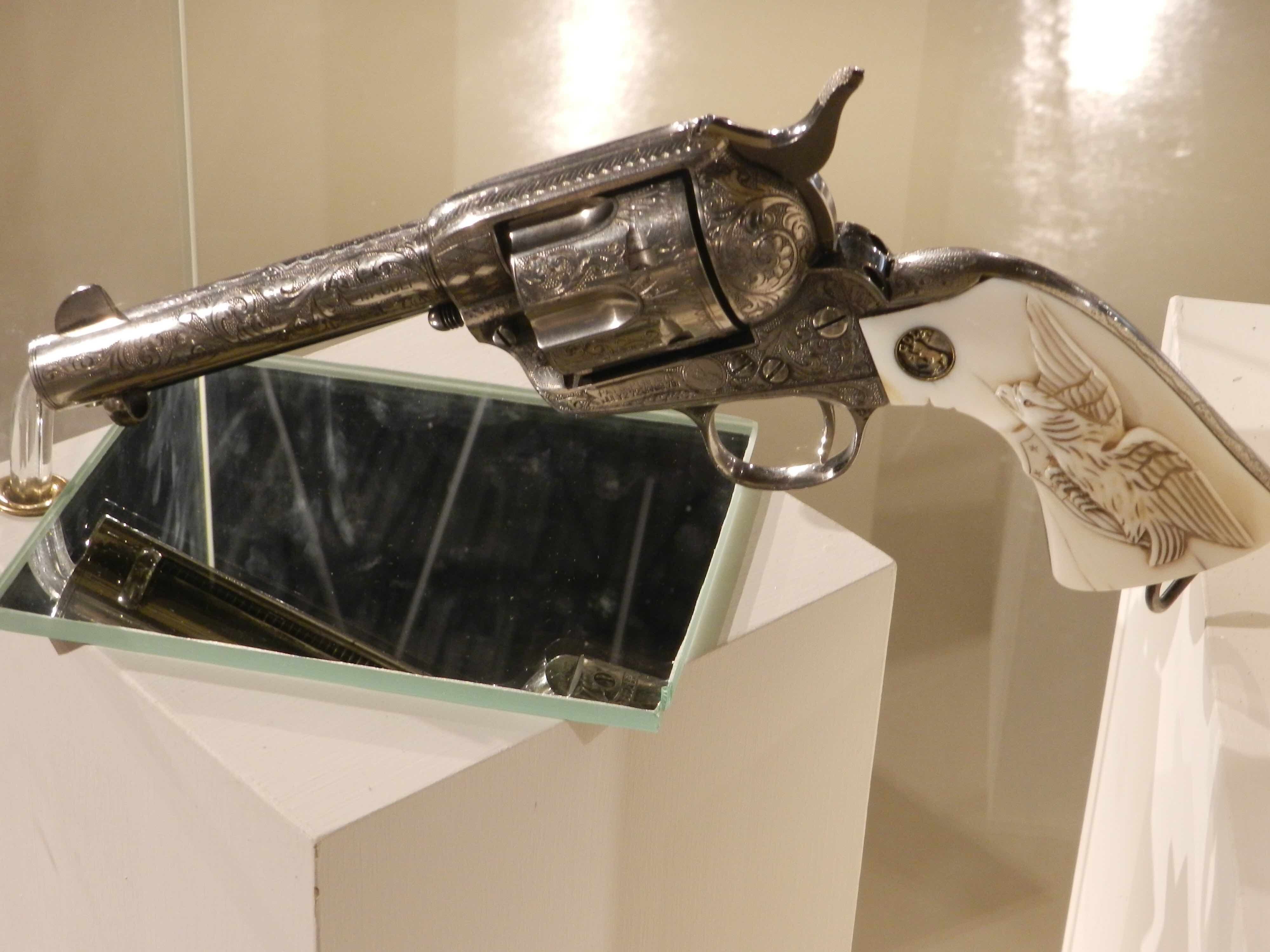Colt Firearms, Hartford Connecticut – March 4, 1916: Item to be shipped: 1 SAA Model P – Serial No. 332088 – 4 ¾ inch barrel – ivory stocked with eagle on left grip – silver plated, scroll engraved – finish work to be completed at destination – Shelton Payne Arms Co. El Paso, Texas….
Rancho de San Miguelito, Chihuahua, Mexico – May 14, 1916 – High Noon: “HALT!” yelled the young cavalry lieutenant, as the threehorsemen riding out of the gated archway veered away from the men he had posted on the southeast side of the hacienda and headed at full-gallop towards him. They had apparently been alerted to make their escape by the man skinning a dead cow in the yard that had run into the ranch house as the soldiers approached, and then came back out again, nonchalantly resuming his work.
“Damnit!” The lieutenant dropped the Springfield rifle he held in his left hand – useless with three riders less than twenty yards away and closing fast – and drew the Colt “Peacemaker” he’d picked up on order in El Paso just before deploying south of the border.
As they turned, the banditos pulled Mauser carbines from scabbards on their saddles and commenced firing as they rode, sending up gravel and bits of adobe into the lieutenant’s face. As he cleared his eyes, he could see the gold lacing on the sleeves… They were Dorados – Villa’s “Golden Ones” – his personal bodyguards.
“ONE, TWO, THREE, FOUR, FIVE!” The lieutenant stood his ground and counted out his shots, knowing he had started with the hammer of the six-shooter resting on an empty chamber, so as not to blow his own foot off by accident. At least one round hit the lead rider in the arm, and another his horse. Both went down in a tangled, dust clouded heap. The lieutenant ducked behind a corner to reload, the wall around him being splattered with bullets. As he emerged, the other two rode past him and he fired three more shots, again hitting both a horse and its rider. The bandito disentangled himself and rose to return fire. Rifle shots from the lieutenant’s men – who had come running up from the southeast side – finished him.
The third rider, thus far unhurt, had cleared the ranch by about a hundred yards and was headed for the hinterlands… But this was no challenge at all for men with 1903 Springfields modified to take powerful .30 ’06 cartridges. Down he went, horse and all, in a hail of bullets.
As they turned back towards the hacienda, it dawned on them that the first rider the lieutenant shot was no longer near his horse but had crawled back inside the house and out the window, shattered arm, bullet holes and all. He too was spotted headed for cover, and a rifle shot brought him down. He raised his good arm as if to surrender, but when approached he reached for his piece. The lieutenant’s scout blew his brains out.
Dust in the distance signaled that more Villaistas were on the way… time to go. The bodies were strapped to the fenders of the open-topped 1915 Dodge touring cars – for this had been the first mechanized attack in U.S. Army history – and off they drove, back to headquarters at Namiquipa.
The General was at first irritated at being interrupted in his meeting, and horrified by the bloated corpses rotting in the sun, but he came around when he was told that one of the bodies had been identified as Julio Cardenas; Pancho Villa’s second-in-command and leader of the famed Dorados. He began calling the lieutenant his own “Little Bandito,” but he ordered those bodies put into the ground will all due haste, and so they were interred with this epitaph: “Ashes to ashes, dust to dust… Villa won’t bury you, so Uncle Sam must…”
Our lieutenant, soon promoted to captain, followed that general – “Black Jack” Pershing – to France in 1917, where he was introduced to an even newer type of vehicle; a Renault FT light tank. By April, he was a Lt. Colonel in charge of the U.S. 1stProvisional Tank Brigade. His first order? No U.S. Tank is to ever be surrendered… Stand and fight, just like hedid at the San Miguelito Ranch.
Then came World War II…
Look closely at the picture of the pistol above…. Can you see the two little notches carved in the ivory between the eagle’s beak and the trigger guard? Those are for Cardenas and the other horseman brought down by its fire. On the other side of the grip are the initials G.S.P. \If you’d like a closer personal inspection of the pistol that’s easy enough to arrange; just visit the museum named after its owner at Fort Knox, Kentucky – the General George Patton Museum of Leadership. And remember, “…no bastard ever won a war by dying for his country. He won it by making that other poor, dumb bastard die for his country….”



Comments
Leave a Reply